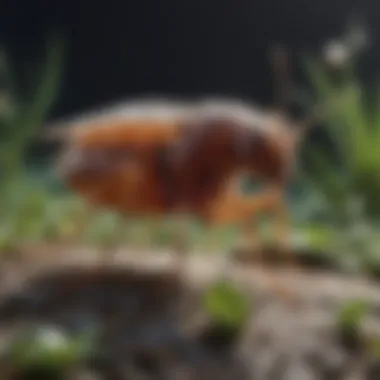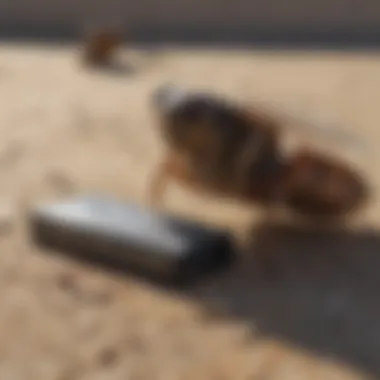Effective Solutions for Flea Removal in Your Outdoor Space


DIY Pest Control Techniques
Empowering homeowners with the tools to combat pests independently, we delve into the realm of do-it-yourself pest control techniques. From crafting homemade solutions using eco-friendly ingredients to harnessing essential oils for natural pest repellents, we equip readers with the knowledge to create bug-free environments sustainably. Exploring the construction of effective pest traps and barriers, we establish barriers against intruders while implementing ethical pest control measures.
Highlighting reputable pest control brands, we showcase products that offer reliable solutions for home pest management. Safeguarding homes with these trusted brands instills confidence in our defense strategies. Additionally, we unveil miscellaneous DIY pest control techniques that cater to specific pest issues, offering a holistic approach to managing diverse intruders with ingenuity and resourcefulness.
Understanding Fleas and Their Behavior
Fleas are tiny, parasitic insects that feed on the blood of mammals and birds, known for their jumping abilities and nuisance they cause to households. In this section, we delve into the crucial aspects of understanding the behavior of these pests. By grasping the behavior patterns of fleas, homeowners can effectively combat infestations and prevent reoccurrences in the yard. Understanding how fleas behave enables homeowners to target their eradication strategies with precision, ensuring a comprehensive approach to flea control.
Identifying Fleas in Your Yard
Identifying fleas in your yard is the first step in mitigating infestations. The presence of fleas may go unnoticed until pets or family members start experiencing bites or itching. Lookout for small, dark-brown insects that move quickly through pet fur or grass. Flea dirt, which appears like small pepper specks, is another indicator of flea activity. Conduct thorough inspections in shady, humid areas like under porches, shrubs, or pet resting spots to identify fleas in their early stages.
Understanding Flea Lifecycle
Different Stages of Flea Development
The flea lifecycle consists of four stages: egg, larva, pupa, and adult. Eggs are laid on hosts or in their surroundings and hatch into larvae, which feed on organic debris. Larvae then enter the pupal stage, forming protective cocoons before emerging as adult fleas. Understanding these stages is crucial for effective flea control, as each stage requires tailored treatments for complete eradication.


Impact of Environment on Flea Survival
The environment plays a significant role in flea survival and reproduction. Fleas thrive in warm, humid conditions, with temperatures between 70-85°F being optimal for their development. High moisture levels aid in egg hatch rates, while organic debris provides food for larvae. Understanding how environmental factors influence flea populations helps homeowners implement targeted prevention measures to disrupt the flea lifecycle and reduce infestation risk.
Preventative Measures to Keep Fleas Away
Preventative measures are crucial in the battle against fleas in your yard. By implementing these strategies, you can prevent infestations and ensure a comfortable environment for your family and pets. Regular maintenance plays a significant role in keeping fleas at bay. From mowing the lawn to clearing clutter and debris, each step contributes to reducing flea habitats. These measures serve as a proactive approach to flea control, minimizing the need for extensive treatments.
Maintaining a Clean Yard
Proper yard maintenance is key to deterring fleas. Regularly mowing the lawn not only improves the aesthetic appeal but also helps reduce hiding spots for fleas. This practice disrupts flea habitats and exposes them to natural elements, decreasing their population. Removing clutter and debris eliminates potential shelters for fleas, making your yard less inviting for these pests. Clearing these objects also enhances ventilation and sunlight exposure, creating an environment that is less conducive to flea survival.
Utilizing Natural Repellents
Natural repellents like lavender and cedarwood chips can be effective in repelling fleas. Lavender emits a fragrance that fleas find unpleasant, driving them away from your yard. Cedarwood chips contain natural oils that act as a deterrent to fleas, making them a valuable addition to your pest control arsenal. These repellents offer a chemical-free alternative to traditional insecticides, minimizing the impact on the environment and your family's health. Essential oils have gained popularity for their flea-repellent properties. Oils like peppermint, eucalyptus, and lemongrass can be diluted and sprayed in problem areas to deter fleas effectively. Their natural ingredients make them safe for use around pets and children.
Effective Treatment Methods for Flea Control
Effective Treatment Methods for Flea Control play a pivotal role in achieving a flea-free environment in your yard. By understanding the importance of implementing the right treatment methods, you can effectively combat flea infestations and ensure the well-being of your family and pets. These strategies are essential to address the root cause of the problem and eradicate fleas from your surroundings. The section will delve into various approaches to flea control, offering insights on both chemical and natural remedies to suit different preferences and situations.


Chemical Treatments
Chemical treatments, such as insecticides and foggers, are widely used for flea control due to their effectiveness in eliminating pests. Insecticides are formulated to target fleas at various life stages, disrupting their reproductive cycle and population growth. They act swiftly to kill existing fleas and provide long-lasting protection against reinfestation. While insecticides offer a quick solution to flea problems, it is essential to follow safety precautions and usage instructions to prevent harm to humans and pets.
Insecticides
Insecticides are a key component of flea control due to their rapid action and targeted effectiveness. These products contain active ingredients that are toxic to fleas but safe for household use when applied correctly. Insecticides work by permeating flea breeding areas, killing adult fleas, larvae, and eggs on contact. Their residual effects can offer extended protection against future infestations, making them a popular choice for homeowners seeking immediate results.
Foggers
Foggers, also known as bug bombs, release insecticidal aerosols to treat large indoor spaces for fleas. They disperse a fine mist that reaches hidden crevices where fleas may hide, effectively eradicating infestations. Foggers are convenient for targeting hard-to-reach areas and can penetrate carpets, furniture, and other flea-prone areas. However, proper application and ventilation are crucial when using foggers to avoid any adverse effects on occupants and pets.
Natural Remedies
Natural remedies offer a safer and eco-friendly alternative to chemical treatments for flea control. Options like diatomaceous earth and beneficial nematodes provide effective solutions without the use of harsh chemicals, making them ideal for households with children and pets. These remedies work in harmony with the environment, targeting fleas while minimizing impact on beneficial organisms.
Diatomaceous Earth
Diatomaceous earth consists of fossilized algae known as diatoms, which have microscopic sharp edges that penetrate and dehydrate fleas. This all-natural powder is safe for humans and pets but effectively kills fleas upon contact by disrupting their protective exoskeleton. Diatomaceous earth can be applied to carpets, pet bedding, and outdoor areas to combat flea infestations without posing health risks to your family.


Beneficial Nematodes
Beneficial nematodes are microscopic roundworms that parasitize and kill flea larvae in the soil. These biological control agents are environmentally friendly and target specific pests without harming beneficial insects or plants. When introduced to the yard, beneficial nematodes actively seek out flea larvae, effectively reducing flea populations and preventing future infestations. Their sustainable approach to flea control makes them a popular choice for environmentally conscious homeowners seeking natural solutions to pest problems.
Professional Pest Control Services
In some cases, severe flea infestations may warrant the assistance of professional pest control services. Pest control experts have the knowledge and resources to assess the extent of the infestation and tailor a treatment plan to address the issue effectively. Their expertise in handling chemicals and specialized equipment ensures thorough eradication of fleas while minimizing risks to occupants and the environment. By engaging professional pest control services, homeowners can gain peace of mind knowing that their flea problem is being managed by trained professionals with access to advanced pest control methods and solutions.
Maintaining a Flea-Free Environment
Maintaining a Flea-Free Environment is crucial in the battle against pesky fleas infiltrating your yard. By diligently practicing preventive measures and effective treatment methods as outlined earlier in this article, you can ensure a comfortable and flea-free outdoor space for yourself, your loved ones, and your beloved pets. A flea-free environment not only promotes a healthier living space but also minimizes the risk of flea bites and potential diseases associated with these parasites.
Regular Inspections and Monitoring
Regular inspections and monitoring play a pivotal role in maintaining a flea-free environment. By conducting routine inspections of your yard, you can promptly detect any signs of flea presence, such as flea dirt or bites on pets or family members. Monitoring involves keeping track of flea populations and identifying potential hotspots where fleas are more likely to thrive. Implementing a systematic inspection and monitoring schedule helps in early intervention and effective control of fleas before infestations escalate.
Consistent Pet Care
Proper pet care is essential for preventing fleas from infesting your yard. Regular grooming of pets not only enhances their cleanliness and overall health but also aids in detecting any fleas at an early stage. Grooming includes brushing your pets' fur to remove dirt and debris, as well as checking for signs of fleas or flea eggs. Additionally, bathing pets with flea-repellent shampoo helps in keeping fleas at bay. Opting for regular grooming as part of your pet care routine is a proactive step in flea prevention.
Regular Grooming
Regular grooming is a fundamental aspect of pet care that contributes significantly to maintaining a flea-free environment. The systematic removal of dirt, debris, and potential fleas from your pets' fur through grooming not only improves their hygiene but also reduces the risk of flea infestations in your yard. The key characteristic of regular grooming lies in its preventive nature, as it allows pet owners to identify and address any flea issues before they escalate. The unique feature of regular grooming is its holistic approach to pet wellness, as it not only targets external parasites like fleas but also fosters bonding between pets and their owners.
Proper Use of Flea Preventatives
Utilizing flea preventatives correctly is paramount in ensuring effective flea control in your yard. Proper use of flea preventatives, such as spot-on treatments or oral medications, offers long-term protection against fleas for your pets. The key characteristic of employing flea preventatives lies in their ability to disrupt the flea life cycle, preventing infestations before they occur. The unique feature of flea preventatives is their convenience and efficacy in safeguarding pets from flea-related discomfort and diseases. While flea preventatives offer numerous advantages in flea control, it is essential to follow the recommended dosage and application instructions to avoid any potential disadvantages.



